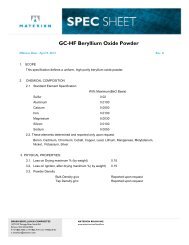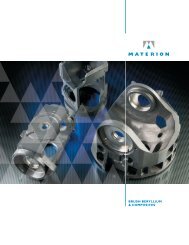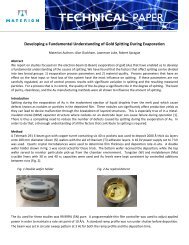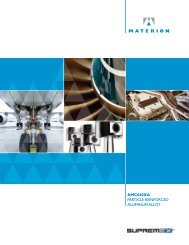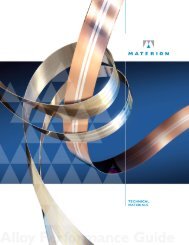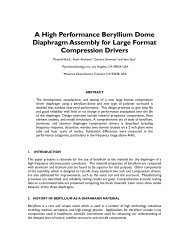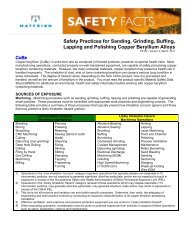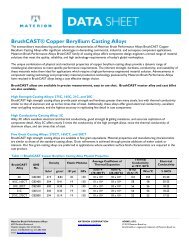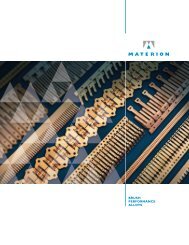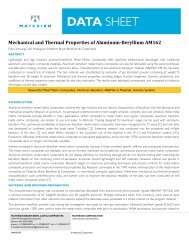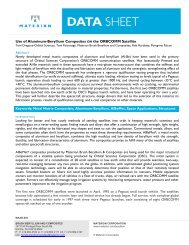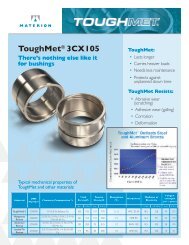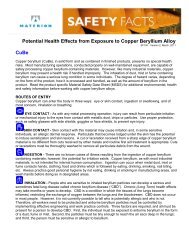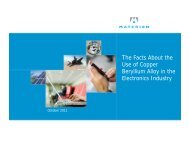<strong>FormaMet</strong> ® - M MSDS No. L48 March 21, 20144. FIRST AID MEASURES4.1 FIRST AID PROCEDURESINHALATION: Breathing difficulty caused by inhalation of particulate requires immediate removal to freshair. If breathing has stopped, perform artificial respiration and obtain medical help.INGESTION: Induce vomiting immediately as directed by medical personnel. Never give anything bymouth to an unconscious person.SKIN: Thoroughly wash skin cuts or wounds to remove all particulate debris from the wound. Seek medicalattention for wounds that cannot be thoroughly cleansed. Treat skin cuts and wounds with standard first aidpractices such as cleansing, disinfecting and covering to prevent wound infection and contamination beforecontinuing work. Obtain medical help for persistent irritation. Material accidentally implanted or lodgedunder the skin must be removed.EYES: Immediately flush eyes with plenty of water for at least 15 minutes, lifting lower and upper eyelidsoccasionally. Get medical attention immediately.5. FIRE FIGHTING MEASURESFlash PointExplosive LimitsExtinguishing MediaUnusual Fire and ExplosionHazardsSpecial Fire Fighting ProceduresNon-combustible as a solid. No ignition as layer of sub 44 micronparticles of copper.Not applicable to solids. No ignition as cloud of sub 44 micron particlesof nominal copper.This material is non-combustible. Use extinguishing media appropriateto the surrounding fire.Do not use water to extinguish fires around operations involving moltenmetal due to the potential for steam explosions.Pressure-demand self-contained breathing apparatus must be worn byfirefighters or any other persons potentially exposed to the metal fumesor dust released during or after a fire.6. ACCIDENTAL RELEASE MEASURES6.1 STEPS TO BE TAKEN IF MATERIAL IS RELEASED OR SPILLEDIf this material is a particulate, establish a restricted entry zone based on the severity of the spill. Personsentering the restricted zone must wear adequate respiratory protection and protective clothing appropriate forthe severity of the spill (see Section 8). Cleanup spills with a vacuum system utilizing a high efficiencyparticulate air (HEPA) filtration system followed by wet cleaning methods. Special precautions must be takenwhen changing filters on HEPA vacuum cleaners used to clean up hazardous materials. Be careful to minimizeairborne generation of particulate and avoid contamination of air and water. Depending upon the quantity ofmaterial released into the environment, the incident may be required to be reported to the National ResponseCenter at (800) 424-8802 as well as the State Emergency Response Commission and Local EmergencyPlanning Committee.7. HANDLING AND STORAGE7.1 HANDLINGParticulate may enter the body through cuts, abrasions or other wounds on the surface of the skin. Wear gloveswhen handling parts with loose surface particulate or sharp edges.7.2 STORAGEStore in a dry area.Page 4 of 10
<strong>FormaMet</strong> ® - M MSDS No. L48 March 21, 20148. EXPOSURE CONTROLS, PERSONAL PROTECTION8.1 VENTILATION AND ENGINEERING CONTROLSWhenever possible, the use of local exhaust ventilation or other engineering controls is the preferred method ofcontrolling exposure to airborne particulate. Where utilized, exhaust inlets to the ventilation system must bepositioned as close as possible to the source of airborne generation. Avoid disruption of the airflow in the areaof a local exhaust inlet by equipment such as a man-cooling fan. Check ventilation equipment regularly toensure it is functioning properly. Provide training on the use and operation of ventilation to all users. Usequalified professionals to design and install ventilation systems.8.2 WORK PRACTICESDevelop work practices and procedures that prevent particulate from coming in contact with worker skin, hair,or personal clothing. If work practices and/or procedures are ineffective in controlling airborne exposure orvisual particulate from deposition on skin, hair, or clothing, provide appropriate cleaning/washing facilities.Procedures should be written that clearly communicate the facility’s requirements for protective clothing andpersonal hygiene. These clothing and personal hygiene requirements help keep particulate from being spreadto non-production areas or from being taken home by the worker. Never use compressed air to clean workclothing or other surfaces.Fabrication processes may leave a residue of particulate on the surface of parts, products or equipment thatcould result in employee exposure during subsequent material handling activities. As necessary, clean looseparticulate from parts between processing steps. As a standard hygiene practice, wash hands before eating orsmoking.To prevent exposure, remove surface scale or oxidation formed on cast or heat treated products in anadequately ventilated process prior to working the surface.8.3 WET METHODSMachining operations are usually performed under a liquid lubricant/coolant flood which assists in reducingairborne particulate. However, the cycling through of machine coolant containing finely divided particulate insuspension can result in the concentration building to a point where the particulate may become airborneduring use. Certain processes such as sanding and grinding may require complete hooded containment andlocal exhaust ventilation. Prevent coolant from splashing onto floor areas, external structures or operators’clothing. Utilize a coolant filtering system to remove particulate from the coolant.8.4 RESPIRATORY PROTECTIONWhen airborne exposures exceed or have the potential to exceed the occupational limits shown in Section 8.13,approved respirators must be used as specified by an Industrial Hygienist or other qualified professional.Respirator users must be medically evaluated to determine if they are physically capable of wearing arespirator. Quantitative and/or qualitative fit testing and respirator training must be satisfactorily completed byall personnel prior to respirator use. Users of tight fitting respirators must be clean shaven on those areas of theface where the respirator seal contacts the face. Exposure to unknown concentrations of particulate requiresthe wearing of a pressure-demand airline respirator or pressure-demand self-contained breathing apparatus(SCBA). Use pressure-demand airline respirators when performing jobs with high potential exposures such aschanging filters in a baghouse air cleaning device.8.5 OTHER PROTECTIVE EQUIPMENTProtective overgarments or work clothing must be worn by persons who may become contaminated withparticulate during activities such as machining, furnace rebuilding, air cleaning equipment filter changes,maintenance, furnace tending, etc. Contaminated work clothing and overgarments must be managed in aPage 5 of 10



